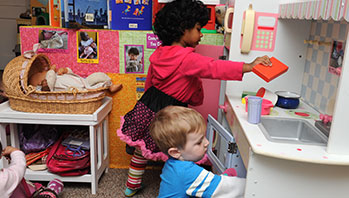- basket
- blanket
- cardboard
- rain coats
- Row, Row, Row Your Boat (book)
- sticks (for beaver dam)
- toy food, plates, etc.
- wrapping paper tubes (to use as oars)
- boat
- food
- picnic
- river
- row
- share
MA Standards:
Literature/RL.PK.MA.3: With prompting and support, act out characters and events from a story or poem read aloud.
Speaking and Listening/SL.PK.MA.5: Create representations of experiences or stories (e.g., drawings, constructions with blocks or other materials, clay models) and explain them to others.
Speaking and Listening/SL.PK.MA.1: Participate in collaborative conversations with diverse partners during daily routines and play.
Head Start Outcomes:
Literacy Knowledge/Book Appreciation and Knowledge: Retells stories or information from books through conversation, artistic works, creative movement, or drama.
Logic and Reasoning/Symbolic Representation: Engages in pretend play and acts out roles.
Language Development/Receptive Language: Attends to language during conversations, songs, stories, or other learning experiences.
PreK Learning Guidelines:
English Language Arts/Language 5: Listen to and use formal and informal language.
English Language Arts/Reading and Literature 10: Engage actively in read-aloud activities by asking questions, offering ideas, predicting or retelling important parts of a story or informational book.
Role Play “Row, Row, Row Your Boat”

© Commonwealth of Massachusetts, Department of Early Education and Care (Jennifer Waddell photographer). All rights reserved.
Skill Focus: Imaginative Play, Listening and Speaking, Recall and Retell, Vocabulary
Supply children with props to recreate scenes from the book Row, Row, Row Your Boat. Model how to place the “oars” in the “water” and stroke. Let children take turns pretending to row the boat and have an adventure on the river. Encourage them to sing “Row, Row, Row Your Boat” as they row.
Adaptation: Groups with varied age groups may wish to pair older and younger children so that the older ones can help the younger ones make up dialogue.
